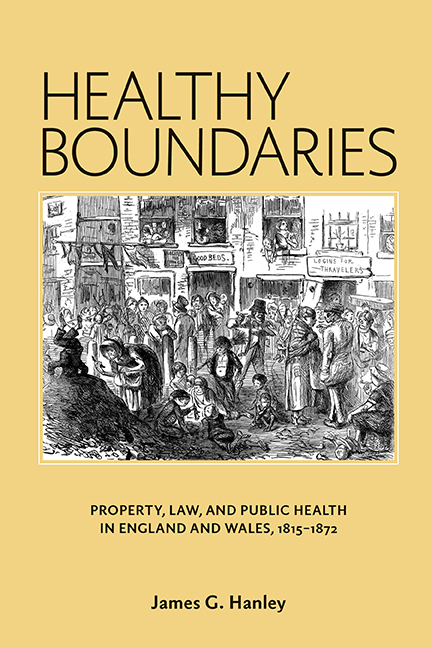Book contents
- Frontmatter
- Dedication
- Contents
- Acknowledgments
- Abbreviations
- Introduction
- 1 The Laws of Nuisance Before 1846: Property, Health, and Democracy in the Age of Reform
- 2 Private Benefit and Public Service: Paying for Sewers Before 1848
- 3 The Boundaries of Health, 1848–70
- 4 The Benefits of Health: London, 1848–65
- 5 Healthy Domesticity, 1848–72
- Conclusion
- Notes
- Bibliography
- Index
- Frontmatter
- Dedication
- Contents
- Acknowledgments
- Abbreviations
- Introduction
- 1 The Laws of Nuisance Before 1846: Property, Health, and Democracy in the Age of Reform
- 2 Private Benefit and Public Service: Paying for Sewers Before 1848
- 3 The Boundaries of Health, 1848–70
- 4 The Benefits of Health: London, 1848–65
- 5 Healthy Domesticity, 1848–72
- Conclusion
- Notes
- Bibliography
- Index
Summary
In 1815, the boundaries of health were very narrowly drawn, and property owners had little to fear from concerns about health. Individuals could not easily be forced to clean up their property, to pay for healthy infrastructure intended to benefit others, or to open their homes to sanitary inspection. By 1872, they could be forced to do all of these things, and many more. This book describes the evolution of the laws that permitted these developments in nineteenth-century England and Wales, and its argument may be simply stated. Between 1815 and 1872, local public servants and commissioners of one kind or another, using public health as their rationale, stimulated a threefold transformation in the nature of property, redefining its salubrity, liability, and sanctity. These changes displayed themselves in the creation of a statutory health hazard (chapter 1), in the minute control of private domestic arrangements (chapter 5), and most important, in a revolution in the financial responsibility for the health of others (chapters 2–4). Redefining the liability of property itself stimulated new and highly controversial ideas of community. Public health thus became an important, if contradictory, site in the creation of communities, enhancing the right to health for some while simultaneously restricting the privacy rights of others in the name of health. These transformations have been studied before, but not, I believe, in such a way as to highlight their common institutional and ideological roots, nor to highlight the way in which they build on recent changes in our understanding of the nature, locus, chronology, and legacy of early English and Welsh public health.
In the earliest and most conventional telling, the English public health movement dated from 1838 and was a story of bureaucratic and parliamentary initiatives, often under utilitarian inspiration. In that year, Edwin Chadwick, secretary to the Poor Law Commission and former secretary to Jeremy Bentham, ordered several pilot inquiries into the health of London's poor. These inquiries triggered a national study, the results of which Chadwick published in 1842 in his Report on the Sanitary Condition of the Labouring Population of Great Britain.
Information
- Type
- Chapter
- Information
- Healthy BoundariesProperty, Law, and Public Health in England and Wales, 1815–1872, pp. 1 - 16Publisher: Boydell & BrewerPrint publication year: 2016
